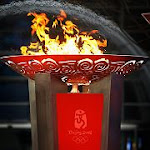Here is the simple point. The cadre does not speak the truth. The cadre has no court system that follows credible evidence and credible testimony. The cadre lacks law and order. The cadre is a riot on its own. Tibet is a conquered country. The 200 people who attended this trial are witnesses to a tireless trope. Without law, there is only the cadre.
Chinese Court Sentences 17
For Role in Tibetan Violence
Associated Press
April 29, 2008 7:31 a.m.
BEIJING -- A Chinese court sentenced 17 people, including six monks, Tuesday to jail terms ranging from three years to life in prison for their roles in deadly riots in the Tibetan capital last month, state media reported.
The Intermediate People's Court of Lhasa announced the sentences at an open session, the official Xinhua News Agency reported.
Two men, including a Buddhist monk identified as Basang, received life sentences, Xinhua said. Basang led 10 people, including five other monks, to destroy local government offices, burn down shops and attack policemen, Xinhua said. Of the five monks, two were sentenced to 20 years, and the other three to 15 years in jail.
The other man who received a life sentence was identified as Soi'nam Norbu, a driver for a Lhasa real-estate company who joined in the mobs that burnt vehicles, smashed police stations and assaulted firefighters during the riot, Xinhua said. He was convicted of arson and disrupting public services, the court said.
No details were given on the 10 other people sentenced. "I believe competent authorities ... will handle them according to the law in a fair and just way," Foreign Ministry spokeswoman Jiang Yu said when asked about the trial.
China's state broadcaster reported that 200 people attended the trial, the first since the mid-March riots.
The massive anti-government protests that turned violent in Lhasa on March 14 were the largest challenge to Chinese rule in the Himalayan region in nearly two decades. China has said 22 people died in the riots while Tibet's government-in-exile announced Tuesday that it believes at least 203 Tibetans were killed in the ensuing crackdown.
The estimate was compiled from a combination of the government's own sources, Tibetan exile groups and official Chinese media. It was impossible to independently verify the information. Access to Tibet and surrounding provinces where protests broke out have been closed to foreigners since the unrest.
Xinhua said the Lhasa violence left seven schools, five hospitals and 120 homes torched and more than 900 shops looted. Total damage was more than 244 million yuan ($35 million).
China's response to the riots has drawn attention to the government's human rights record and other policies, as the communist country prepares to host the Olympic Games in August.
Rights groups and pro-Tibetan supporters have protested against the Olympic torch relay at several stops around the world, causing massive disruptions in some cities.
After weeks of international pressure by the U.S. and the European Union, China announced last week it would be willing to begin talks with representatives to the Dalai Lama, the exiled spiritual leader of Tibet whom Beijing has blamed for fomenting the unrest. No specifics were given on when or where a possible meeting would occur. On Tuesday, the Foreign Ministry's Jiang said that "specifics of the contact and consultation have still yet to be further discussed."
The sentences came a day after Tibetan authorities announced the reopening of the Sera Monastery, which was closed after last month's riots, Xinhua reported. "Monks have been taught legal knowledge in recent days and the monastery has resumed normal religious activities," Tenzin Namgyal, deputy director of the Tibet Autonomous Regional Ethnic and Religious Affairs Committee, was quoted as saying.
Other monasteries that were closed will be reopened soon, he said.
Chinese authorities have increased patriotic education classes that require monks to make ritual denunciations of the Dalai Lama, accept the Chinese-appointed Panchen Lama, and pledge allegiance to Beijing.
The protests, initially led by Buddhist monks, started peacefully on March 10, the anniversary of a failed Tibetan uprising against Chinese rule. They became violent four days later as Tibetans attacked cars and shops run by Han Chinese, China's majority ethnic group.
Police and armed troops surrounded Lhasa's three main monasteries -- Sera, Drepung and Ganden -- along with the sacred Jokhang temple during the demonstrations. They were then closed off as authorities investigated which monks had been involved in the unrest.
Copyright © 2008 Associated Press
Subscribe to:
Post Comments (Atom)


No comments:
Post a Comment